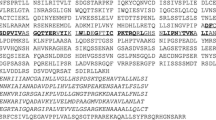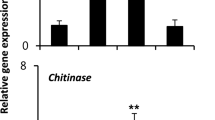Abstract
A rice gene, OsBIANK1, encoding a protein containing a typical ankyrin repeat domain, was cloned and identified. The OsBIANK1 protein, consisting of 329 amino acids, contains a conserved ankyrin repeat domain with two ankyrin repeats organized in tandem and was showed to be localized on cytoplasmic membrane during transient expression in onion epidermal cells. Expression of OsBIANK1 was induced by treatment with benzothiadiazole (BTH), a chemical inducer capable of inducing disease resistance response in rice. In BTH-treated rice seedlings, expression of OsBIANK1 was further induced by infection with Magnaporthe grisea, the rice blast fungus, as compared with those in water-treated seedlings. Our preliminary results confirm previous evidences that OsBIANK1 may be involved in regulation of disease resistance response in rice.




Similar content being viewed by others
Abbreviations
- ANK:
-
Ankyrin
- BTH:
-
Benzothiadiazole
- GFP:
-
Green fluorescent protein
- SA:
-
Salicylic acid
References
Sedgwick SG, Smerdon SJ (1999) The ankyrin repeat: a diversity of interactions on a common structural framework. Trends Biochem Sci 24:311–316. doi:10.1016/S0968-0004(99)01426-7
Mosavi LK, Cammett TJ, Desrosiers DC, Peng ZY (2004) The ankyrin repeat as molecular architecture for protein recognition. Protein Sci 13:1435–1448. doi:10.1110/ps.03554604
Becerra C, Jahrmann T, Puigdomenech P, Vicient CM (2004) Ankyrin repeat-contianing proteins in Arabidopsis: characterization of a novel and abundant group of genes coding ankyrin-transmembrane proteins. Gene 340:111–121. doi:10.1016/j.gene.2004.06.006
Bouche N, Scharlat A, Snedden W, Bouchez D, Fromm H (2002) A novel family of calmodulin-binding transcription activators in multicellular organisms. J Biol Chem 277:21851–21861. doi:10.1074/jbc.M200268200
Stone JM, Liang X, Nekl ER, Stiers JJ (2005) Arabidopsis AtSPL14, a plant-specific SBP-domain transcription factor, participates in plant development and sensitivity to fumonisin B1. Plant J 41:744–754. doi:10.1111/j.1365-313X.2005.02334.x
Stone SL, Williams LA, Farmer LM, Vierstra RD, Callis J (2006) KEEP ON GOING, a RING E3 ligase essential for Arabidopsis growth and development, is involved in abscisic acid signaling. Plant Cell 18:3415–3428. doi:10.1105/tpc.106.046532
Choi, Kim MC, Yoo JH, Moon BC, Koo SC, Park BO, Lee JH, Koo YD, Han HJ, Lee SY, Chung WS, Lim CO, Cho MJ (2005) Isolation of a calmodulin-binding transcription factor from rice (Oryza sativa L.). J Biol Chem 280:40820–40831. doi:10.1074/jbc.M504616200
Huang J, Chen F, Casino CD, Autino A, Shen M, Yuan S, Peng J, Shi H, Wang C, Cresti M, Li Y (2006) An ankyrin repeat-containing protein, characterized as a ubiquitin ligase, is closely associated with membrane-enclosed organelles and required for pollen germination and pollen tube growth in lily. Plant Physiol 140:1374–1383. doi:10.1104/pp.105.074922
Nodzon LA, Xu WH, Wang Y, Pi LY, Chakrabarty PK, Song WY (2004) The ubiquitin ligase XBAT32 regulates lateral root development in Arabidopsis. Plant J 40:996–1006. doi:10.1111/j.1365-313X.2004.02266.x
Wang YS, Pi LY, Chen X, Chakrabarty PK, Jiang J, De Leon AL, Liu GZ, Li L, Benny U, Oard J, Ronald PC, Song WY (2006) Rice XA21 binding protein 3 is a ubiquitin ligase required for full Xa21-mediated disease resistance. Plant Cell 18:3635–3646. doi:10.1105/tpc.106.046730
Chinchilla D, Merchan F, Megias M, Kondorosi A, Sousa C, Crespi M (2003) Ankyrin protein kinases: a novel type of plant kinase gene whose expression is induced by osmotic stress in alfalfa. Plant Mol Biol 51:555–566. doi:10.1023/A:1022337221225
Seong ES, Choi D, Cho HS, Lim CK, Cho HJ, Wang MH (2007) Characterization of a stress-responsive ankyrin repeat-containing zinc finger protein of Capsicum annuum (CaKR1). J Biochem Mol Biol 40:952–958
Wirdnam C, Motoyama A, Arn-Bouldoires E, van Eeden S, Iglesias A, Meins F (2004) Altered expression of an ankyrin-repeat protein results in leaf abnormalities, necrotic lesions, and the elaboration of a systemic signal. Plant Mol Biol 56:717–730. doi:10.1007/s11103-004-4679-9
Kumagai H, Hakoyama T, Umehara Y, Sato S, Kaneko T, Tabata S, Kouchi H (2007) A novel ankyrin-repeat membrane protein, IGN1, is required for persistence of nitrogen-fixing symbiosis in root nodules of Lotus japonicus. Plant Physiol 143:1293–1305. doi:10.1104/pp.106.095356
Zhang H, Scheirer DC, Fowle WH, Goodman HM (1992) Expression of antisense or sense RNA of an ankyrin repeat-containing gene blocks chloroplast differentiation in arabidopsis. Plant Cell 4:1575–1588
Albert S, Despres B, Guilleminot J, Bechtold N, Pelletier G, Delseny M, Devic M (1999) The EMB 506 gene encodes a novel ankyrin repeat containing protein that is essential for the normal development of Arabidopsis embryos. Plant J 17:169–179. doi:10.1046/j.1365-313X.1999.00361.x
Ha CM, Jun JH, Nam HG, Fletcher JC (2004) BLADE-ON-PETIOLE1 encodes a BTB/POZ domain protein required for leaf morphogenesis in Arabidopsis thaliana. Plant Cell Physiol 45:1361–1370. doi:10.1093/pcp/pch201
Norberg M, Holmlund M, Nilsson O (2005) The BLADE ON PETIOLE genes act redundantly to control the growth and development of lateral organs. Development 132:2203–2213. doi:10.1242/dev.01815
Garcion C, Guilleminot J, Kroj T, Parcy F, Giraudat J, Devic M (2006) AKRP and EMB506 are two ankyrin repeat proteins essential for plastid differentiation and plant development in Arabidopsis. Plant J 48:895–906. doi:10.1111/j.1365-313X.2006.02922.x
Kuhlmann M, Horvay K, Strathmann A, Heinekamp T, Fischer U, Böttner S, Droge-Laser W (2003) The α-helical D1 domain of the tobacco bZIP transcription factor BZI-1 interacts with the ankyrin-repeat protein ANK1 and is important for BZI-1 function, both in auxin signaling and pathogen response. J Biol Chem 278:8786–8794. doi:10.1074/jbc.M210292200
Seong ES, Cho HS, Choi D, Joung YH, Lim CK, Hur JH, Wang MH (2007) Tomato plants overexpressing CaKR1 enhanced tolerance to salt and oxidative stress. Biochem Biophys Res Commun 363:983–988. doi:10.1016/j.bbrc.2007.09.104
Cao H, Glazebrook J, Clarke JD, Volko S, Dong X (1997) The Arabidopsis NPR1 gene that controls systemic acquired resistance encodes a novel protein containing ankyrin repeats. Cell 88:57–63. doi:10.1016/S0092-8674(00)81858-9
Ryals J, Weymann K, Lawton K, Friedrich L, Ellis D, Steiner HY, Johnson J, Delaney TP, Jesse T, Vos P, Uknes S (1997) The Arabidopsis NIM1 protein shows homology to the mammalian transcription factor inhibitor I kappa B. Plant Cell 9:425–439
Rate DN, Cuenca JV, Bowman GR, Guttman DS, Greenberg JT (1999) The gain-of-function Arabidopsis acd6 mutant reveals novel regulation and function of the salicylic acid signaling pathway in controlling cell death, defenses, and cell growth. Plant Cell 11:1695–1708
Lu H, Rate DN, Song JT, Greenberg JT (2003) ACD6, a novel ankyrin protein, is a regulator and an effector of salicylic acid signaling in the Arabidopsis defense response. Plant Cell 15:2408–2420. doi:10.1105/tpc.015412
Lu H, Liu Y, Greenberg JT (2005) Structure-function analysis of the plasma membrane-localized Arabidopsis defense componment ACD6. Plant J 44:798–809. doi:10.1111/j.1365-313X.2005.02567.x
Yan J, Wang J, Zhang H (2002) An ankyrin repeat-containing protein plays a role in both disease resistance and antioxidation metabolism. Plant J 29:193–202. doi:10.1046/j.0960-7412.2001.01205.x
Chern MS, Fitzgerald HA, Yadav RC, Canlas PE, Dong X, Ronald PC (2001) Evidence for a disease-resistance pathway in rice similar to the NPR1-mediated signaling pathway in Arabidopsis. Plant J 27:101–113. doi:10.1046/j.1365-313x.2001.01070.x
Chern MS, Fitzgerald HA, Canlas PE, Navarre DA, Ronald PC (2005) Overexpression of a rice NPR1 homolog leads to constitutive activation of defense response and hypersensitivity to light. Mol Plant Microbe Interact 18:511–520. doi:10.1094/MPMI-18-0511
Yuan Y, Zhong S, Li Q, Zhu Z, Lou Y, Wang L, Wang J, Wang M, Li Q, Yang D, He Z (2007) Functional analysis of rice NPR1-like genes reveals that OsNPR1/NH1 is the rice orthologue conferring disease resistance with enhanced herbivore susceptibility. Plant Biotechnol J 5:313–324. doi:10.1111/j.1467-7652.2007.00243.x
Fridborg I, Grainger J, Page A, Coleman M, Findlay K, Angell S (2003) TIP, a novel host factor linking callose degradation with the cell-to-cell movement of Potato virus X. Mol Plant Microbe Interact 16:132–140. doi:10.1094/MPMI.2003.16.2.132
Song F, Goodman RM (2002) OsBIMK1, a rice MAP kinase gene involved in disease resistance responses. Planta 215:997–1005. doi:10.1007/s00425-002-0794-5
Chiu WI, Niwa Y, Zeng W, Hirano T, Kobayashi H, Sheen J (1996) Engineered GFP as a vital reporter in plants. Curr Biol 6:325–330. doi:10.1016/S0960-9822(02)00483-9
Niwa Y, Hirano T, Yoshimoto K, Shimizu M, Kobayashi H (1999) Non-invasive quantitative detection and applications of non-toxic, S65T-type green fluorescent protein in living plants. Plant J 8:455–463. doi:10.1046/j.1365-313X.1999.00464.x
Du J, Wang X, Zhang M, Tian D, Yang YH (2007) Unique nucleotide polymorphism of ankyrin gene cluster in Arabidopsis. J Genet 86:27–35. doi:10.1007/s12041-007-0004-0
Rechsteiner M, Rogers SW (1996) PEST sequences and regulation by proteolysis. Trends Biochem Sci 21:267–271
Kinkema M, Fan W, Dong X (2000) Nuclear localization of NPR1 is required for activation of PR gene expression. Plant Cell 12:2339–2350
Zhang Y, Fan W, Kinkema M, Li X, Dong X (1999) Interaction of NPR1 with basic leucine zipper protein transcription factors that bind sequences required for salicylic acid induction of the PR-1 gene. Proc Natl Acad Sci USA 96:6523–6528. doi:10.1073/pnas.96.11.6523
Fan W, Dong X (2002) In vivo interaction between NPR1 and transcription factor TGA2 leads to salicylic acid-mediated gene activation in Arabidopsis. Plant Cell 14:1377–1389. doi:10.1105/tpc.001628
Gorlach J, Volrath S, Knauf-Beiter G, Hengy G, Beckhove U, Kogel KH, Oostendorp M, Staub T, Ward E, Kessmann H, Ryals J (1996) Benzothiadiazole, a novel class of inducers of systemic acquired resistance, activates gene expression and disease resistance in wheat. Plant Cell 8:629–643
Ge X, Song F, Zheng Z (1999) Systemic acquired resistance to Magnaporthe grisea in rice induced by BTH. Acta Agric Zhejiangensis 11:311–314
Song F, Ge X, Zheng Z, Xie Y (2001) Benzothiadiazole induces systemic acquired resistance in rice against bacterial leaf blight. Chin J Rice Sci 15:323–326
Zhang W, Ge X, Song F, Zheng Z (2004) Systemic acquired resistance of rice against sheath blight disease induced by benzothiadiazole. Acta Phytophylacica Sin 30:171–176
Song FM, Goodman RM (2002) Molecular cloning and characterization of a rice phosphoinositide-specific phospholipase C gene, OsPI-PLC1 that is activated in systemic acquired resistance. Physiol Mol Plant Pathol 61:31–40
Hu X, Song F, Zheng Z (2006) Molecular characterization and expression analysis of a rice protein phosphatase 2C gene, OsBIPP2C1, and overexpression in transgenic tobacco conferred enhanced disease resistance and abiotic tolerance. Physiol Plant 127:225–236. doi:10.1111/j.1399-3054.2006.00671.x
Luo H, Song F, Goodman RM, Zheng Z (2005) Up-regulation of OsBIHD1, a rice gene encoding BELL homeodomain transcriptional factor, in disease resistance responses. Plant Biol 7:459–568. doi:10.1055/s-2005-865851
Luo H, Song F, Zheng Z (2005) Overexpression in transgenic tobacco reveals different roles for the rice homeodomain gene OsBIHD1 in biotic and abiotic stress responses. J Exp Bot 56:2673–2682. doi:10.1093/jxb/eri260
Song D, Song F, Zheng Z (2006) A novel rice MAPK gene, OsBIMK2, is involved in disease resistance responses. Plant Biol 8:587–596. doi:10.1055/s-2006-924149
Acknowledgments
The authors thank Mr. Rongyao Chai (Zhejiang Academy of Agricultural Science, Hangzhou, China) for the Magnaporthe grisea isolate 85-14B1. This study was supported by National Natural Science Foundation of China (grants no. 30771399), the National “863” Project (2007AA10Z140) and the Ph.D. Programs Foundation of Ministry of Education of China (No. 20070335111).
Author information
Authors and Affiliations
Corresponding author
Rights and permissions
About this article
Cite this article
Zhang, X., Li, D., Zhang, H. et al. Molecular characterization of rice OsBIANK1, encoding a plasma membrane-anchored ankyrin repeat protein, and its inducible expression in defense responses. Mol Biol Rep 37, 653–660 (2010). https://doi.org/10.1007/s11033-009-9507-5
Received:
Accepted:
Published:
Issue Date:
DOI: https://doi.org/10.1007/s11033-009-9507-5




